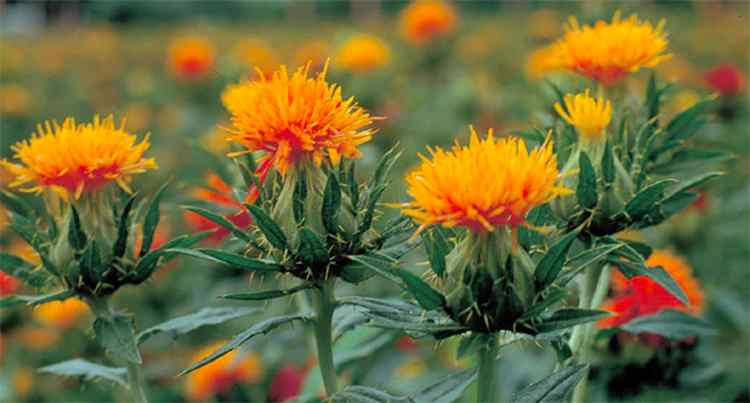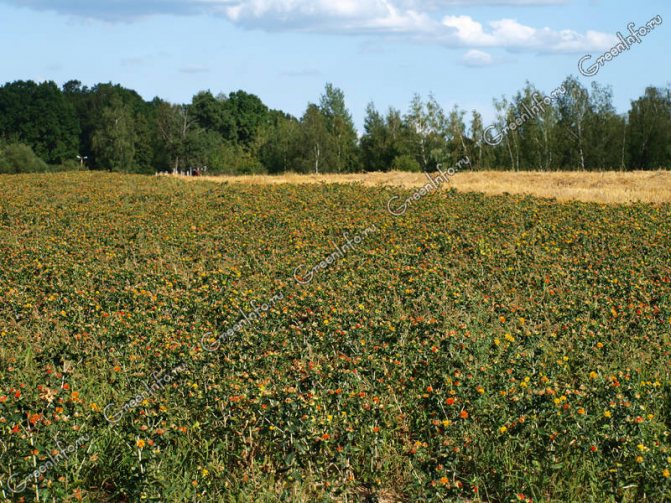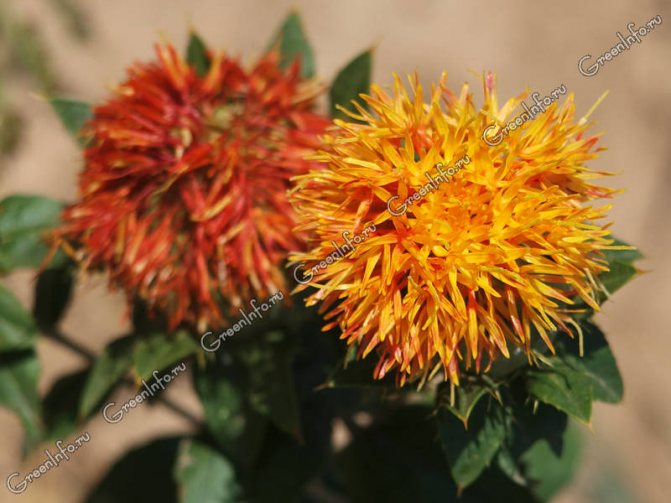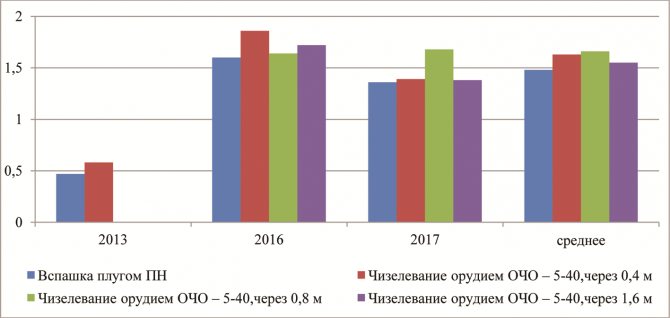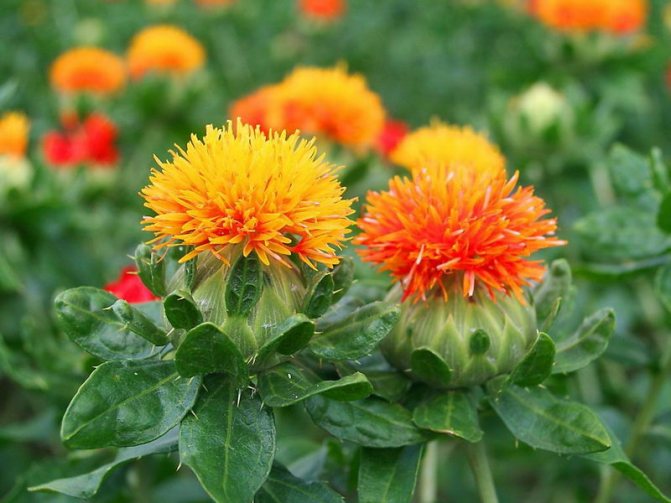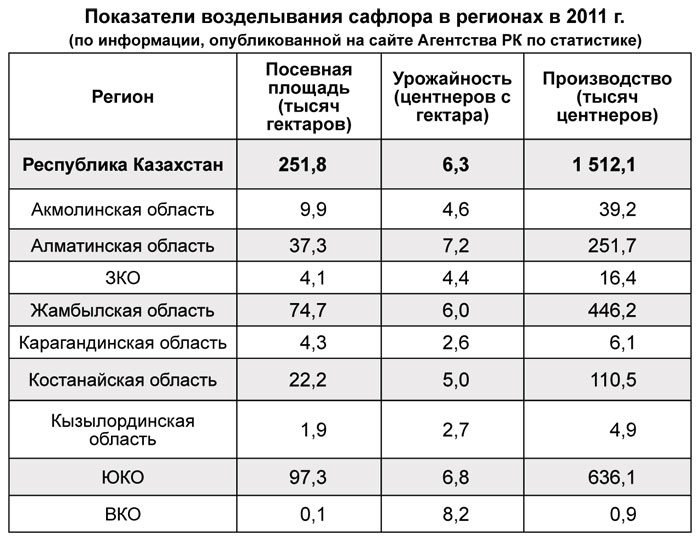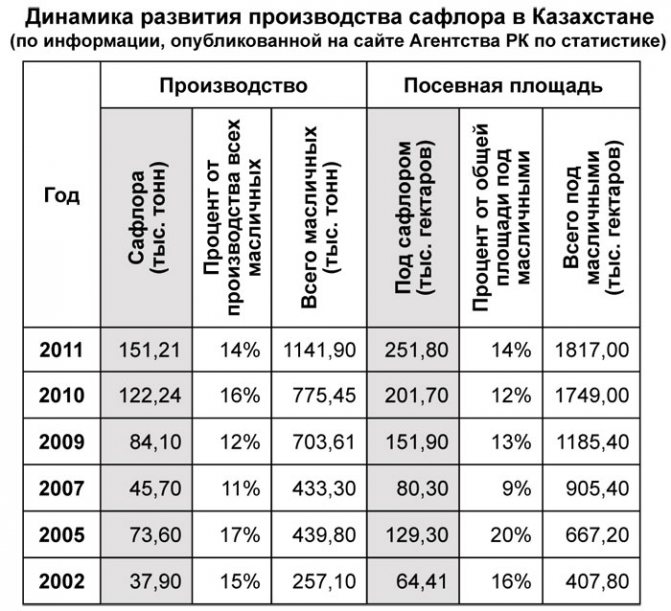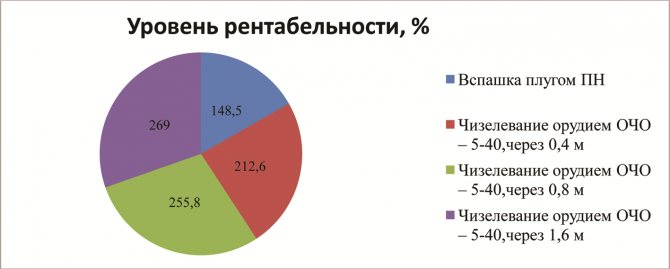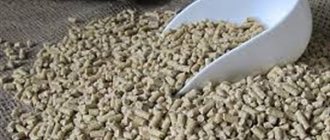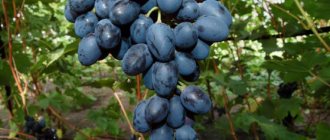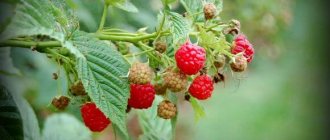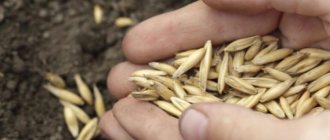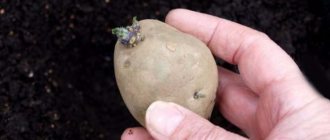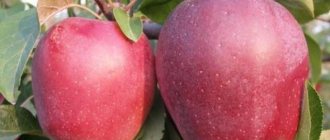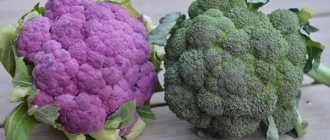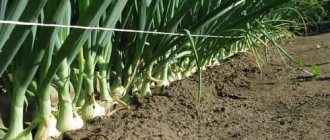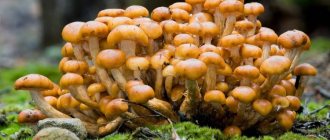Useful properties of safflower oil
Safflower flowers contain vitamins A, C and D. In addition, the flowers contain glycosides, magnesium, iron and other minerals. The oil contained in the seeds is composed of many unsaturated fatty acids. The seeds also contain lignanan alcohols.
Given the richness of its active ingredients, safflower has many beneficial properties:
- diuretic effect,
- thins the blood, thereby improving blood circulation,
- a prophylactic agent for psoriasis and malignant tumors,
- helps to reduce weight,
- improves brain activity,
- useful for hypertensive patients,
- boosts immunity.
But for the majority, safflower is known as a plant, the use of which in the form of a dietary supplement is useful for losing weight.
Properties of honey
- very rare, since safflower is not a honey plant, it blooms for a very short time and emits little nectar at the same time. Safflower honey has many beneficial properties, as it is rich in vitamins and nutrients such as calcium, iron, vitamins E, C, PP and group B. honey is used for arthritis, skin diseases, cuts and burns, you can use honey for diseases throat - it produces an analgesic effect, is useful for insomnia.
Safflower honey is also used in cosmetology. Masks based on it are useful for the scalp and hair.
To increase and maintain immunity, every morning you need to drink a glass of water with diluted honey on an empty stomach (for 1 glass - 2 teaspoons).
The benefits of tea
Safflower tea is recommended to drink to normalize digestion processes, treat gastritis and ulcers, is useful for liver and kidney diseases, thins the blood, and normalizes blood pressure. Preparing tea is easy: take 1/4 teaspoon of color (do not mix with other teas), pour it into a container and pour boiling water, leave for about half an hour, then filter. It is recommended that you drink one cup before bed, but you can drink several during the day. Store tea in a cool and dry place.
Oil application
This oil is close to olive oil in price, it can be found in supermarkets and pharmacies, but it is better to buy it in aromatherapy departments. The oil is actively used to lose weight, improve heart function, cleanse blood vessels, and improve the condition of the skin and hair. It is also useful for patients with diabetes mellitus: it lowers sugar levels and removes excess fats.
The beneficial properties of safflower are due to the chemical composition of the flowers and seeds of the plant. So, the flowers contain chalcone glycosides, among which are: cardamidine, cartamine, isocartamine. The seeds, in turn, contain 60% fatty oils.
Safflower herb decoction is used to relieve chronic constipation. It improves intestinal motility, helps to normalize its microflora.
It is recommended to use safflower infusion as an auxiliary treatment for erosive and ulcerative lesions of the stomach and intestines. The remedy can be used for gastritis, as well as for various forms of hepatitis.
Safflower has a diuretic effect. In this regard, it is recommended to use it both for the general cleansing of the body from toxins and other decay products, and for the treatment of diseases of the urinary system. Safflower-based infusions and decoctions help to get rid of edema.
Through the use of safflower, blood circulation in the body can be improved.The plant has the ability to thin the blood, which is the treatment and prevention of atherosclerosis, heart attack, stroke.
Safflower is used as a prophylactic agent for the threat of psoriasis and malignant tumors. The substances included in its composition contribute to the normalization of metabolic processes in the body, cleanse the liver and kidneys from decay products, and have antitoxic properties.
Safflower is recommended to be used for the treatment of gynecological diseases, for the normalization of the menstrual cycle, for amenorrhea in adolescence. Safflower is able to relax smooth muscles, it is recommended as an adjuvant for heavy bleeding during menopause, with prolonged postpartum bleeding.
As part of complex therapy, safflower is used to get rid of endocrine pathologies. In particular, safflower oil helps to get rid of extra pounds faster, which is especially important in diabetes mellitus.
Infusion and decoction of safflower helps to reduce the rheumatic pains characteristic of rheumatoid arthritis. Moreover, decoctions and infusions based on plant flowers can be taken orally and used externally.
The body's immune defenses are enhanced, the immune response is normalized with the proper use of safflower-based medicines.
So, safflower is used for medicinal purposes to achieve a diuretic, choleretic, laxative, blood-thinning effect.
The beneficial properties of safflower used in the food industry. Safflower flowers are widely used to obtain a red, yellow, saffron-colored dye that is bladeless for human health. The coloring matter is kartamine. Dyes are used in the food industry, they are added mainly to confectionery products to give them the desired color. Safflower oil is used to make margarine. Its flowers are used to make medicinal tea.
Useful properties of safflower used in cosmetology. For the cosmetic industry, safflower oil is of particular value. It consists mainly of linoleic acid, which has a moisturizing effect, nourishes and strengthens the skin, and enhances its blood circulation.
Safflower is not considered a melliferous plant, so it should be planted together with other melliferous plants. Flowers appear from mid-summer and bloom until the end of August. If conditions are favorable, then from 5 hectares of safflower, bees can produce up to 2.5 kg of honey every day.
Honey contains a significant amount of potassium and iodine, slightly less sodium, manganese, copper, calcium, phosphorus, selenium and other minerals. Amino acids, enzymes, proteins, dextrins, vitamin C, vitamin E, vitamin PP, vitamins of group B are present in safflower honey. In addition, it contains fatty acids: palmitic, lauric, arachidonic, oleic and others.
Safflower honey is used in cosmetology and medicine, masks and applications are made from it for scabies, dermatitis, rosacea, burns, psoriasis, lichen. honey helps to prevent age-related changes in the skin, prevents its aging, has a tonic effect.
Masks based on safflower honey are useful for hair and scalp. They improve the nutrition of the hair, making it smoother and shinier. As part of complex therapy, safflower honey allows you to fight baldness.
Inside, honey is taken not only as a delicacy, but also as a prophylaxis for diseases such as: thrombophlebitis, arterial hypertension, heart attack, stroke, amenorrhea, endometritis, gastritis, gastric ulcer and intestinal ulcer, enterocolitis.
Compresses with honey help with arthritis, helping to reduce pain, relieve inflammation.
The use of natural safflower honey will help in the treatment of angina, laryngitis, pharyngitis, bronchitis.It is advisable to take it orally for the treatment of any colds. If honey is mixed with warm milk, then you can get a mild analgesic effect of a sore throat. In addition, honey has a bactericidal and mucolytic effect.
To maintain immunity, it is useful to drink a glass of water with honey diluted in it (2 teaspoons per glass) every morning on an empty stomach. You can supplement this immune-boosting drink with lemon juice. Such a useful habit will have a positive effect on metabolism, metabolism will normalize, it will be possible to improve appetite, and reduce swelling.
If you take safflower honey before bedtime, you can get rid of insomnia, reduce the negative impact on the psyche of stress, and more effectively relieve nervous tension.
Safflower honey should be purchased only from trusted manufacturers who value their reputation and will not allow it to be spoiled by letting go of a fake. You should not choose honey for its bright orange color, as freshly pumped safflower honey has a transparent consistency and a slight yellow tint when viewed in the sun. Frozen safflower honey has a fat-like consistency and a light yellow color.
Safflower tea is brewed from the flowers of the plant. Its long-term use contributes to the provision of a pronounced diuretic effect, and so strong that a person is able to experience the urge to urinate with an empty bladder. In this case, you need to stop drinking tea for two weeks.
It is recommended to drink safflower tea for heart failure, anemia, numbness of the upper and lower extremities. If you drink tea for six months, you can get rid of the manifestations of these diseases, according to Chinese traditional medicine.
Normalization of the digestion process,
Prevention and treatment of gastritis, ulcers, hepatitis C,
Improving the nutrition of the skin,
Cleansing the liver and kidneys,
Elimination of the consequences of previous strokes,
Blood pressure normalization,
Improving overall tone.
Store safflower tea in a cool, dark place. It should not be brewed with other teas. To prepare a drink, you will need to place a quarter of a teaspoon of tea in a cup and pour boiling water over it. The time for the tea to be infused is from 20 minutes to half an hour. After that, the drink is filtered and drunk.
Another safflower tea option is safflower water. It is an effective treatment for psoriasis. This requires that some of the safflower is always present in drinking water. To prepare it, you will need 4 liters of boiled water, to which a teaspoon of dry raw materials is added.
- History of uterine bleeding. To stop uterine bleeding, safflower can be used only after consultation with a doctor and under his supervision.
- The period of bearing the fetus. The use of safflower during pregnancy threatens miscarriage and premature birth, since the substances that make up the plant are able to relax the smooth muscles of the uterus.
- Chronic diseases that require the systematic administration of drugs.
- Gastrointestinal disorders, diarrhea. The fact is that safflower has the property of enhancing intestinal motility, which, in case of diarrhea, can lead to dehydration.
- Individual intolerance to plant components.
Expert-editor: Sokolova Nina Vladimirovna | Phytotherapist
Education: Diploma in "General Medicine" and "Therapy" received at the University named after NI Pirogov (2005 and 2006). Advanced training at the Department of Phytotherapy at the Peoples' Friendship University of Moscow (2008).
Other doctors
The way to grow strawberries all year round
Within the former USSR, this complex occupies about 2.9 million hectares. The above limits of the seeding rate of safflower are due to the following.A decrease in the seeding rate below 18 kg / ha leads to a significant decrease in yield, a slowdown in the processes of soil reclamation, in particular, its settlement and desolonization.
An example of the implementation of the method of growing safflower
Sowing of safflower was carried out on representative worst soils in terms of salinity and solonetzicity: 50 wt% solonchak solonetzes, 25 wt% solonetzic light chestnut soils and 25 wt% meadow chestnut soils. Safflower seeds had a purity of at least 95% and a germination rate of at least 85%.
On the soils of the reclaimed solonetz complex, the yield of oilseeds decreased less than on light soils. In addition, in relation to mustard, safflower showed a higher drought resistance and better adaptability to unfavorable soil conditions. Safflower withstood the catastrophic drought of 1998, with the complete death of mustard and all other crops, in the Trans-Volga region, he gave a harvest on a solonetzic complex on a stubble of 1.5 c / ha.
Read also: Lagenaria: composition, benefits, application
CLAIM
A method of growing safflower, including sowing safflower seeds in saline soil, characterized in that the soil is used as saline soil, containing from 50 to 60 wt.% Of saline solonetzes and from 20 to 30 wt.% Of saline solonetzic light chestnut soils, the rest is meadow - chestnut soils, while sowing sows from 18 to 20 kg of seeds per hectare with the placement of seeds with an inter-row spacing of not more than 0.3 m.
Now sit and think, what to buy and sow safflower or chickpeas? If the respected community permits, then I will express some of my thoughts on this matter. Chickpea. Legume culture. Like all legumes, it can take nitrogen into the soil from the atmosphere.
But for this, it will probably need to be infected with bacteria. In nature, for chickpeas, such as peas, there are no bacteria. Chickpeas are drought-resistant, but low-yielding.
Does not sufficiently cover the soil with its above-ground mass. And, in conditions of normal moisture supply, chickpeas cannot compete with weeds. It can only be protected with anti-grain herbicides.
Chickpeas require a fairly clean agrophone. In the conditions of the Sumy region, it will probably be difficult to maintain pure chickpea crops. Using the drought tolerance of chickpea, it is therefore grown in the southern regions.
Safflower. The culture is also drought tolerant. According to the information in this thread, safflower is good at controlling the development of weeds. When sowing it in a continuous way.
For some reason, safflower crops are being developed only in the southern regions. Can someone from our zone who was engaged in this culture will respond? I would like to try.
A question on this topic for the experienced. He was already in the subject. But there was no answer. Is it possible to obtain oil from safflower using conventional sunflower oil production technology? I am also attracted by safflower as a honey plant.
During its flowering, just bee colonies already have sufficient development. Which can favorably affect the pollination of this crop. This means also the yield.
I am judging this as a former beekeeper who devoted more than twenty years to this occupation.
The smell of fresh stubble, I carry through life And grain in the bulk, as in my childhood I carry. ————————————————————
- Login or register to post comments
Composition and useful properties
Medicinal substances are concentrated in saffron flowers, its seeds, which allowed representatives of traditional and folk medicine to use the plant and its properties for medicinal and prophylactic purposes.
Safflower flowers contain:
- cartamine,
- cardamidine,
- isocartamine,
- luteolin glycoside,
- chalconic glycosides,
- essential oil with a high content of caryophyllene.
Safflower seeds are considered no less valuable medicinal raw materials:
- oil with a high content of polyunsaturated acids,
- vitamin E,
- protein.
Thanks to a set of useful substances, dye safflower has a beneficial effect, first of all, on the human heart and blood vessels. The beneficial properties of saffron contribute to:
- lowering blood cholesterol levels and cleansing blood vessels,
- normalization of the process of hematopoiesis and clinical parameters of the blood picture,
- normalization of the work of female reproductive organs,
- improving peristalsis and bowel function,
- cleansing the liver and bile ducts,
- normalization of the excretory system,
- normalization of metabolic processes in the body,
- normalization of the immune system and activation of the body's defenses.
Results of studies on the use of safflower
A number of different research organizations have carried out work to study the properties of this plant, and I want to share some of them.
In 1976, experiments were conducted in the USA with participants with problems with hypertension (140 people). They took flower safflower oil (57 grams per day) for 3 weeks. The results showed that safflower oil can help lower blood pressure and cholesterol levels.
In 1989, the UK experimented with safflower oil on patients with moderate hypertension and hypertension, taking the oil from mashed flowers every day for 4 weeks (5.9 g per day). The results concluded that safflower oil can actually help lower blood pressure.
Experiments were carried out on rats, which were injected with doses of safflower, 2500 times higher than the norm for humans. It was found that the plant did not cause toxic symptoms and did not lead to poisoning.
Clinical analysis has shown that safflower extract has properties similar to female hormones. It has the effect of stimulating the uterus and female hormones, helps to shrink the uterus and smooth muscles. But using too much can cause uterine cramps.
Experiments were conducted on rats with high cholesterol levels. After a 30-day course, a 36% reduction in cholesterol was found.
When writing the article, data from a number of sources were used, including the Faculty of Pharmacy of Ubon Ratchathani University, the encyclopedia of Thai herbs and others.
As you can see, safflower has a number of valuable medicinal properties that determine its use in various natural medicines. At the same time, it is necessary to take into account the existing contraindications, to prevent overdose - especially in the search for safflower capsules containing only this component. Also, long-term or constant use should not be allowed. By following these simple recommendations, you can safely use the beneficial properties of this plant to strengthen your health.
*The information on our website is a Thai translation of resources that work with doctors and specialists to provide accurate information. However, the content on this site is for additional, general educational information only.
The materials on the site are not intended to diagnose or self-medicate in any way and will not replace a qualified medical examination and diagnosis. If you have any illness or discomfort, see your doctor. We are against self-medication, we are for a reasonable approach to health improvement.
Plant application
Saffron is used in pharmacology and cosmetology. Representatives of traditional medicine widely use the properties of a medicinal herb to treat a number of diseases.
- treatment with safflower decoction of chronic constipation and intestinal motility disorders allows the patient to normalize the intestinal microflora within three weeks of regular intake. Thanks to its restorative and healing properties, medicinal safflower gently normalizes intestinal motility and restores the natural microflora,
- The useful properties of the medicinal herb have found application in the preparation of tinctures and medicines for ulcerative and erosive lesions of the stomach and intestines, gastritis, and various forms of hepatitis. In the treatment of these diseases, saffron is used as an adjuvant in complex therapy,
- cleansing the liver and renal system. The diuretic properties of saffron have found application in the system of complex cleansing of the body, ridding the kidneys and liver of toxins and decay products,
- improvement of blood circulation processes. Saffron is known as an effective blood thinner, which makes it possible to use this property in a complex of preventive and therapeutic measures at the risk of atherosclerosis, stroke, heart attack. These properties are also used as part of the complex therapy of these diseases and other cardiovascular pathologies that occur against the background of a violation of hematopoiesis,
- prevention of malignant neoplasms and psoriasis. The plant has a pronounced antitoxic and cleansing effect, cleans the liver, kidneys, blood vessels. One of the reasons for psoriatic lesions of the skin is considered to be a violation of the body's immune response, intoxication. The anti-toxic properties of safflower contribute to the normalization of metabolic processes, prevent the occurrence of cancerous tumors and psoriatic eruptions,
- treatment of gynecological pathologies. Saffron has pronounced properties of normalizing the menstrual cycle. Used to treat and prevent cycle disorders, adolescent amenorrhea. Due to the relaxing effect on smooth muscles, saffron infusion is used to eliminate postpartum complications in the form of bleeding, climacteric profuse bleeding,
- use in the complex therapy of endocrine disorders. Safflower oil contains omega fatty acids that can help the body burn fat. This property, combined with the action of the methanol extract of the plant, makes it possible to use safflower for the treatment of obesity, diabetes mellitus,
- treatment of rheumatic pains in rheumatoid and metabolic arthritis. Infusion and decoction of saffron flowers has established itself as an effective pain reliever that has a beneficial effect on the joints from the inside and outside, relieving inflammation. Regular use of safflower medicines helps to reduce rheumatic manifestations and reduce pain, including senile,
- treatment of immune pathologies. The natural fatty acids in safflower act as hormone-like substances that control muscle contractions. These properties have a beneficial effect on the body's immune response, stabilizing the immune system, restoring metabolic processes.
Brewed safflower flowers eliminate inflammation, have a good effect on brain function by increasing and improving blood flow, and reducing the risk of stroke. This drink is even used to prevent the appearance of malignant tumors and psoriasis. Very good safflower flowers help with amenorrhea and metritis in women.
They also relieve rheumatic pains. Tea intake influences very well
It lowers its viscosity and at the same time lowers blood pressure. Tea has a general strengthening effect on the body, reduces fatigue, tones up and invigorates. For medicinal purposes, use the edge flowers of the basket. They are collected at the moment of full disclosure. Flowers contain a lot of nutrients.
Various parts of the plant are used in medicine, industry, food production and other industries. However, it is primarily an oilseed crop.
Safflower seeds are used to produce safflower oil, which can be eaten. It has all the basic qualities of a plant, so it helps with diabetes, obesity, problems with the skin and blood vessels. But do not forget that in ancient times it was used as an abortifacient, so it is strictly not recommended to take it during pregnancy.
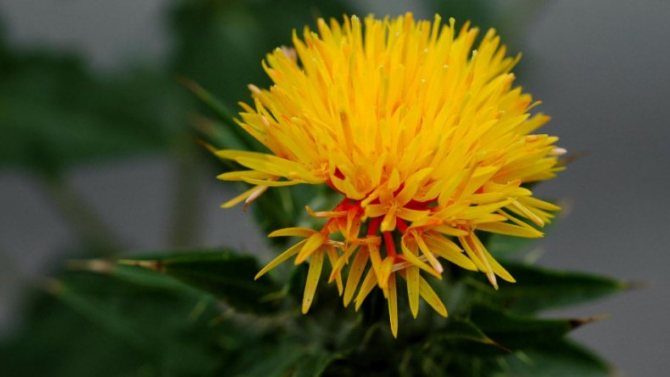
Safflower oil is also used in industry - it is added to white paints to avoid yellowing, in the manufacture of linoleum, soap, drying oil. The dye obtained from safflower is used to dye carpets.
Safflower seeds are rich in nutrients and microelements that remain in them even after the oil is pressed. Therefore, safflower cake is sent for animal feed.
Beekeepers get safflower honey from this plant, which also has a lot of useful properties. In addition to being used for food, it can be used to make masks for the face, scalp and hair, and make compresses to combat arthritis. Safflower honey is good for treating colds, and a couple of spoons of this honey for tea before bedtime improves the general condition of the body.
When the harvest is carried out
The petals are harvested only after the buds have fully bloomed. In order for the flowers to retain their beauty, drying is recommended as quickly as possible. This is quite simple to do. Difficulties can arise only with large inflorescences.
Dry the safflower with the heads down. Plants are hung up one at a time or in small bunches. This will help prevent mold growth. It is best to carry out the procedure in a room that is well ventilated and has low humidity. Drying plants in direct sunlight is not recommended. Such blanks will retain a small amount of useful vitamins and minerals.
Safflower is not only a beautiful but also a very useful plant. Therefore, in order for the harvesting to bring as much benefit as possible, you should adhere to the rules of care and follow the recommendations for harvesting.
Unique properties of safflower - video
Safflower history
In Europe, saffron was used mainly to extract oil from it, and also as a dye. This explains its modern name - dyeing safflower.
Since the discovery of other dyes, the plant has almost ceased to be interested, but now it can be said to be being rediscovered:
- In many countries - for example, the USA, Australia, India and Mexico - it is grown as an oilseed crop.
- Safflower is a medicinal plant, and the oil obtained from its seeds is the main ingredient in many medicinal preparations, and the cake is used for animal feed. The honey obtained from it is also useful.
- It is also used as an aphrodisiac in some countries.
Many medicinal plants and their uses were studied by humans several thousand years ago. The properties of safflower were known 3000 years ago. Fragrant balms and aromatic oils were made from flowers, which were used in baths and Greek halls. In China, the first mentions of safflower are found in documents from 1061.
In this country, the plant was used to treat pneumonia, gastritis, leucorrhoea and amenorrhea. In Egypt, mummy bandages were painted with safflower solution. What a multifaceted application, isn't it? Growing and harvesting safflower is a laborious process. Therefore, it is used mainly for the preparation of medicines and in cooking.
Safflower for birds. Versatile usefulness
The biological characteristics of the culture and its adaptive potential correspond to the hot conditions of the Southern Steppe of Ukraine. In dry years, when winter rape freezes, it is safflower that can stabilize the production of oilseeds. The cultivation technology of this crop does not provide for special agrotechnical measures and agrochemicals, therefore it easily fits into the existing zonal farming system.
Safflower is widely used in many industries, different countries have their own traditions and culture of its use - dyeing, food, medical, cosmetic, fodder. However, it is predominantly known as an oilseed crop, since its seeds contain 32 to 39% semi-drying oil (in the core 50-56%). Safflower is similar in fatty acid composition to sunflower.The oil contains the following fatty acids: linoleic - 88.3%, oleic - 7.6%, palmitic - 5.5%, stearic - 0.65%, linolenic - 0.2%. The oil is used for food and technical purposes, for the production of margarine, drying oil, high-quality snow-white enamel, which does not turn yellow over time, soap, linoleum, etc. Safflower seeds are bitter due to the presence of bitter substances in the shell, therefore, for the manufacture of edible oil, shelling is carried out seeds.
Safflower also contains inulin, which helps to normalize blood glucose levels, exhibits anti-sclerotic, choleretic, diuretic effects, and regulates the function of the thyroid gland.
As a fodder crop, it is used in pure form and in mixtures. Animals eat well the green mass of safflower without thorns. The cake from unhulled safflower seeds contains 6-7% oil, 24-25% starch and 19% protein, 100 kg contains 50 feed units and 13.3 kg of digestible protein. Although the cake is bitter, animals quickly get used to it and eat it well. Safflower hemicarps are useful food for birds.
Application in medicine: folk recipes
For a long time, the annual was used in medicine as a laxative, pain reliever, and a remedy for the treatment of cardiovascular diseases.
Today, the plant has found antioxidant and anti-inflammatory properties, and it also lowers total cholesterol levels, and is used for diabetes.
Safflower has been used in folk medicine for several centuries. With its help, tumors are treated, used as a remedy for bruises and injuries.
And now let's get acquainted with several folk recipes for the use of safflower.
- The concentrate is consumed one tablespoon once a day.
- Ground seeds are added to shampoo to help with hair loss.
- The oil is added to sunscreen products in a 1: 5 ratio.
- Add to scalp and hair care products (1 tablespoon per 100 ml).
- Against rosacea, it is applied to the skin of the face in its pure form.
- Added to creams for sensitive or aging skin.
- Used as a massage oil for dry skin.
- In cooking, it is added to salads instead of sunflower oil.
If you decide to buy safflower at the “grandmother's” market, you should: the first plant has a less vivid odor, flowers are variegated with a yellowish tinge, consisting of small inflorescences.
Safflower oil for cholesterol
Safflower fatty oil, given the presence of polyunsaturated fatty acids, has the ability to reduce the content of harmful cholesterol and is a means of preventing atherosclerosis and hypertension, and, accordingly, strokes and heart attacks.
|
Outwardly, poultices and ointments from flowers are used in the treatment of burns, boils, and poorly healing wounds. The oil is a good cosmetic agent for problem skin and a base for hair care products, especially for weakened, brittle and dry hair. In creams, the oil is used to care for dry and aging skin. And, of course, similar to milk thistle oil, it is useful as salad oil in dietary nutrition.
Photo: Rita Brilliantova
Appearance
To find out safflower in nature (what it is, we discussed), you need to have an idea of its appearance. The height of the annual plant reaches one, and sometimes one and a half meters. The stem of the plant is branched and has a whitish gloss. Safflower leaves are quite dense.
They have an oblong shape and slightly jagged edges. Their color is green. The upper leaves are smaller and promote good photosynthesis. They, like thistles, have sharp thorns. Safflower blooms from June to September. Inflorescences reach 3.5 centimeters in diameter. Safflower petals are yellow or orange-red in color.
Safflower is a herb with a fairly massive stem and fleshy leaves covered with thorns.Safflower can grow up to 150 cm in height, but it is usually much shorter. A distinctive feature of the plant are large, fluffy inflorescences of bright orange color. They contain dyes. When the safflower fades, the seeds ripen - oblong white seeds.
The genus Safflower has about two dozen species, among which only one is cultivated - safflower dye, to which this article is devoted. All the rest are wild or weedy and do not represent any benefits from the point of view of use in everyday life, medicine or cooking.
Description of the plant
This annual grows up to 1.5 in height. Sometimes there are species that do not exceed 40 cm in height. The stem is straight with a glossy white color. The leaves are oblong, whole, with numerous thorns along the edges. The flowers are tubular. They can be bright yellow or orange. The fruit is a white, oval achene. The benefits and harms of safflower are directly related to its composition. The following substances were found in its flowers and seeds:
- chalconic glycosides;
- starch;
- fatty acids (oleic, linoleic, stearic, palmitic);
- vitamins A, D, K and E;
- iron;
- magnesium.


Cold pressed safflower oil contains about 80% linoleic fatty acid. It is not synthesized by the human body, but it is an irreplaceable substance for normal life. The flower petals contain a large amount of coloring pigments. Among them, cartamine (red pigment) and safflowergel (yellow pigment) predominate.
The harm of safflower oil and contraindications
Safflower, the photo of which is in this article, is not very susceptible to diseases and pests. This distinguishes it from other oil crops. Among the main diseases are rust, fusarium, broomrape and septoria. Rust is very dangerous for safflower. It is a fungal disease that manifests itself as round, brown pustules on the leaves.
It can affect all crops and reduce yields. In order to combat this disease, chemical treatment is carried out. The correct agrotechnical measures and the selection of varieties that are resistant to diseases are considered effective. Among the main pests are the safflower fly and weevil, moth and aphid.
The safflower fly is the most dangerous. Adults lay eggs inside the bud, which subsequently damage them. Weevil beetles affect the leaves, stems and leaves of the inflorescence. Their larvae feed on achenes and ovaries during their ripening period. Aphids and moths are less common. For the destruction of pests, chemical treatment is carried out.
Safflower is not recommended for uterine bleeding, as it thins the blood and can increase or cause bleeding.
It is contraindicated to use it during pregnancy - it can cause premature birth.
Cannot be used when a person has problems with the gastrointestinal tract, and with individual intolerance to the components.
And in conclusion, I would like to note that although safflower looks like a panacea, you should consult a doctor before using it.
When treating with safflower-based drugs, you need to be especially careful, as this plant does not combine well with some medications, especially with anticoagulant drugs. In addition, safflower is contraindicated for:
- pregnancy,
- reduced blood clotting.
Safflower seeds are a useful product that has found application in various areas of human life. Usually safflower seed is used as an alternative to sunflower seeds - as a source of fatty oil. In addition, safflower seeds are used to feed poultry.
Vegetable oil is extracted from safflower seeds, which is characterized by a high percentage of nutrients. Safflower oil is colorless and odorless and has a slightly bitter taste.Safflower oil is used in cooking, folk medicine, and various industries. The drug contains a large amount of linoleic acid, which has a beneficial effect on human cardiovascular activity and lowers blood cholesterol levels. Safflower oil is a dietary product and is recommended for patients with diabetes mellitus.
A decoction of safflower flowers is also called safflower tea. It helps to improve the functioning of the gastrointestinal tract, as well as restore the functions of the liver and kidneys. To prepare the infusion, you need to take ¼ tsp. dry, crushed flowers and pour a glass of water. You need to insist such tea under the lid for half an hour. Safflower tea is recommended to be drunk once a day, before going to bed.
In cooking
- safflower oil and plant flowers are used in cooking,
- safflower is a great alternative to saffron,
- safflower oil does not smoke well, which is why chefs like to use it for deep-fried cooking,
- in the East, plants use petals to paint products yellow or orange,
- safflower oil dressing salads,
- dried safflower petals are used to season dishes of meat, poultry and fish,
- safflower goes well with legumes and cereals,
- safflower petals are added to black, green, flower or herbal teas.
Safflower flowers, seeds and oil are used in folk medicine for the treatment and prevention of various kinds of ailments, including:
- diseases of the heart and blood vessels,
- dysmenorrhea,
- amenorrhea,
- endometriosis,
- coronary artery disease,
- pneumonia,
- jaundice,
- gastritis,
- rheumatism,
- skin lesions
- intestinal inflammation,
- stomach ulcer.
- pregnancy and breastfeeding,
- acute pancreatitis,
- diseases of the bile ducts,
- problems with intestinal peristalsis,
- allergy.
Symptoms of an overdose of the drug are severe dizziness and headache, nausea, vomiting, diarrhea, lack of appetite. If you consume safflower oil in moderation and coordinate the appointment with your doctor, you can protect yourself from serious consequences and not harm the body.
Safflower use in cooking. Safflower (Carthamus tinctorius), Wild Saffron, American Saffron
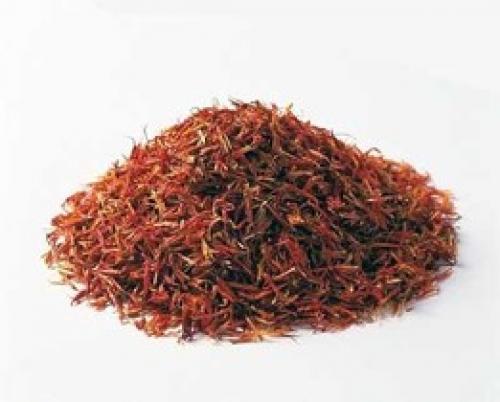

The use of safflower in cooking is very diverse. They can simply replace saffron, or you can get oils and food colors. Safflower in another way is also called American saffron, dyeing thistle, wild saffron, dyeing saffron.
Currently, safflower is found both wild and domesticated. It grows throughout the East, China, North Africa, the Mediterranean, Turkestan, the Caucasus and the Crimea. It can be found in some regions of Russia and Ukraine.
Safflower is interesting for two reasons. Firstly, food colors can be obtained from the petals of the plant - saffron, red and yellow. And secondly, oil can be obtained from safflower. At first, oil was actively used in regions of Central Asia with an arid climate, where it was used as a sunflower oil.
Today, safflower seed oil is very popular all over the world. I must say that this oil not only has the largest amount of saturated fatty acids, but also a very high smoke point, which is very convenient for deep-fried cooking.
It should also be noted that safflower oil is perfect for cold snacks and salads, because it does not freeze even at low temperatures. The oil is clear and almost tasteless, but still has an interesting floral scent. It is curious that safflower oil does not contain vitamin E, but this does not make it less nutritious, because there are many other useful substances there. If you have heart problems, or you want to avoid them in the future, then safflower oil can come to the rescue.
It is interesting to know that saffron is very often substituted for saffron, this is especially true for oriental cooking. For a very long time, the spice was called saffron and was used along with the latter.
Planting and caring for safflower
The soil should be prepared in advance, in the fall. At the same time, it is necessary to apply nitrogen fertilizers, which safflower prefers. It will be necessary to harrow and dig up the soil not only in the autumn, but also in the spring, before planting.
Before introducing seeds into open ground, they are etched using a weak solution of potassium permanganate. This must be done a month before sowing. You can sow seeds as early as April. The plant is frost resistant. The distance between the rows must be at least 50 cm. The first shoots can be seen 7-14 days after planting, and the plant will begin to bloom after 2 months.
The plant has a strong root system, so it tolerates drought well. Safflower should be watered no more than once a week, it is best to do this in the evening. A condition for good growth of safflower is the absence of weeds. Weeding and loosening should be carried out at a time when the first 4 leaves appear. Spraying the grass is not recommended. You can replenish the safflower with a manure solution. No further special processing is required.
Harvesting should be done after it is fully ripe. Safflower is resistant to diseases and pests, so its cultivation is not difficult. The collected grass is dried and stored in a dark, well-ventilated area.
Sowing the right timing is very important for any crop. Future harvests depend on this. In areas with an arid climate, it is necessary to sow and get seedlings as early as possible. The root system of the plant will have time to gain strength before the onset of drought and will provide the plant with moisture from the depths of the soil. Sowing can be very early, at the same time as planting spring crops.
The plant requires minimal maintenance. The first is breaking the soil crust. Secondly, the thinning of seedlings after their emergence. Like any plants, safflower does not like the neighborhood with weeds. Therefore, regular weeding is required. Contamination of crops with pink thistle reduces yields by 70 percent. The plant does not need much moisture, so the soil is moistened as needed.
The soil should be prepared in advance, in the fall. At the same time, it is necessary to apply nitrogen fertilizers, which safflower prefers. It will be necessary to harrow and dig up the soil not only in the autumn, but also in the spring, before planting.
Before introducing seeds into open ground, they are etched using a weak solution of potassium permanganate. This must be done a month before sowing. You can sow seeds as early as April. The plant is frost resistant. The distance between the rows should be at least 50 cm. The first shoots can be seen 7-14 days after planting, and the plant will begin to bloom after 2 months.
The plant has a strong root system, so it tolerates drought well. Safflower should be watered no more than once a week, it is best to do this in the evening. A condition for good growth of safflower is the absence of weeds. Weeding and loosening should be carried out at a time when the first 4 leaves appear. Spraying the grass is not recommended. You can replenish the safflower with a manure solution. No further special processing is required.
Harvesting should be done after it is fully ripe. Safflower is resistant to diseases and pests, so its cultivation is not difficult. The collected grass is dried and stored in a dark, well-ventilated area.
Cultivation technology
The sowing period is foreseen simultaneously with spring grain crops. A delay in planting by five days reduces the yield by up to 25%, and by 12 days by almost 50%. In the best terms of sowing, the yield is more than 10 c / ha. According to experiments, safflower must be sown early - in the first 4-5 days of spring field work. The optimum planting depth for safflower is 5-6 cm.The early sowing period provides an increase in safflower yield by 3.0 c / ha with row spacing of 70 cm and by 3.8-4.0 c / ha with row spacing of 15 cm in comparison with the late period.
An increase in the seeding rate of safflower seeds to 340 thousand pcs / ha gives an increase in yield with a row spacing of 70 cm by 1.2-3.5 c / ha and 1.2-2.2 c / ha when growing crops with a row spacing of 45 cm. with a row spacing of 45 cm at all seeding rates formed a yield of 1.5-3.2 c / ha more than crops with a row spacing of 70 cm.
But a continuous method of sowing with approximately the same rate is also possible, which gives even better results under the condition of weak weed infestation.
Caring for safflower crops consists in loosening row spacings and weeding.
Harvesting safflower begins when it is fully ripe, when all the plants and baskets turn yellow and the seeds are fully ripe. In case of significant contamination of crops with weeds, two-phase harvesting can be carried out. Safflower seeds are difficult to separate only from sunflower and cocklebur, all other weeds are easily separated during cleaning. Safflower, unlike sunflower, does not emit sticky resin and therefore, after cleaning, the seeds, after cleaning, do not even contain stuck ragweed achenes and other harmful weeds. Undoubtedly, the most acceptable harvesting of safflower by direct combining with complete drying of plants.
You can harvest with grain harvesters. The best results in harvesting safflower are obtained by a harvester with a pin drum at a reduced speed of up to 750-800 per minute and with a sparse first section of the deck through one pin.


Biological features
This plant cannot be called whimsical. Its seeds germinate at 2-3 degrees Celsius. The sprouts can withstand short-term frosts from 4 to 6 degrees. Therefore, this crop can be planted both in spring and autumn. It should be noted that plants planted in autumn give higher yields. Safflower is especially demanding for heat during flowering and seed ripening. During this period, rainy weather is not desirable.
Otherwise, the flowers will be poorly pollinated. Mild drought is preferable. Seedlings appear as early as 8-10 days after sowing. The growing season lasts an average of 100-110 days. Flowering begins 70 days after germination, which lasts about a month. The baskets do not open evenly.
Safflower growing technology
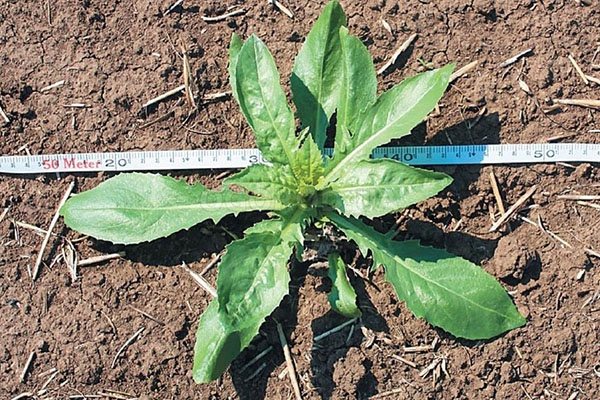

Since the plant belongs to the group of heat-loving crops, the conditions must be appropriate. This applies not only to the choice of the site, but also to watering, fertilization.
Landing place
Sowing safflower should be in those areas where previously grew wheat, rapeseed, oats, flax. It is not recommended to choose beds after sunflowers, carrots, beets or sorghum. In such a place, the flower will develop poorly and will not please with beautiful, abundant flowering. This is due to the fact that such plants are able to draw out a large amount of moisture and useful trace elements from the soil.
In one place safflower can be grown for one season. Re-sowing in the same area should only be done after 4 years.
What should be the soil
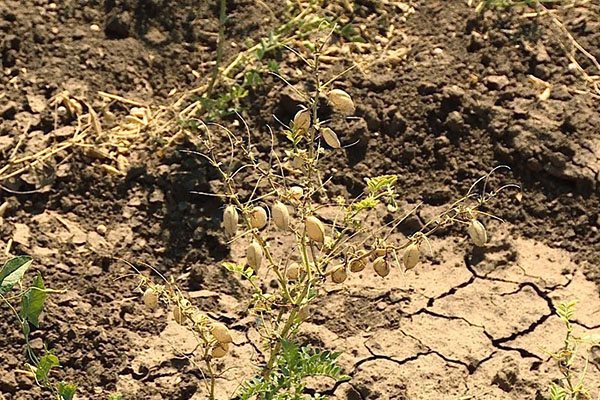

Safflower soil doesn't really matter. The plant grows well on different soils, but most of all the culture prefers chernozems, loams, sub-sandy substrates. Safflower also thrives on saline lands.
Before starting sowing, the soil must be plowed. This should be done to a depth of about 20 cm. This will help get rid of many weeds that can negatively affect the development of the plant.
Seeding time and rate
Planting is carried out together with grain crops. The seeds tolerate low temperatures and freezing well. If the procedure is carried out late, then there may be little moisture in the upper soil layer for the grains to germinate.
To increase the germination rate, as well as to protect the planting material from insects, you can treat the seeds with the help of the drug "Premis" or "Cardon.
It is necessary to deepen the grains no more than 8 cm.The distance between the rows should be within 60 cm.1 hectare will require from 30 to 40 kg of safflower. It all depends on the conditions, soil moisture.
Safflower for orchids. Orchid substrate
- I had 2 phalaenopsis growing in pure expanded clay for a whole year - an adult, but tortured plant (Little Zebra) from the markdown "for discard", and baby, I don't remember the variety, and it doesn't matter. Little Zebra was planted in an ordinary transparent pot for orchids with a diameter of 12 cm, did not make holes on the sides, it turns out, only the bottom drainage holes. The baby was put in a very leaky basket - a glass (the walls have the same name). They were planted this way because of a mass transplant - and they did not have enough bark. I planted in haste, what I had to do, covered with expanded clay, and it was interesting what would happen. And it was great for them - both plants added very well in growth, the roots came out gorgeous, the other day I transplanted them in a larger container, and so the roots were very healthy, there were no shriveled or rotten ones. When planting, Little Zebra had very few roots - and I pulled it out of expanded clay with roots - which were stacked on top of each other in rings along the bottom of the pot, and when I pulled it out - it calmly stood on its roots, like on a pot. The child had so many plump roots that they had to cut the pot to each hole - the roots stuck out from each hole, they did not fit into the pot. In general, I confirm that expanded clay is very good, it is very suitable for phalaenopsis, it looks beautiful, the roots grow healthy, the expanded clay does not allow them not to dry out, nor to rot from waterlogging, it is convenient to water, it is not necessary to soak the bark, there is no need to worry about the roots not breathe or fungi or pests have started up in the substrate. Good way. After such an experience, I transferred half of the orchids to CEOFLORA - it is like expanded clay, only even cooler. But I didn’t find the topic of ceoflora. I'll write one thing - I don't know how I used to live…. So many problems with flowers are solved by such a substrate, well, just almost everything!
Safflower seeds. Safflower - a means for losing weight, healthy blood vessels and much more
Today, my friend greedy for secrets in Thai pharmacy, we will talk about a plant called safflower, known to mankind since the times of Ancient Egypt, where it was used as a dye for fabrics and dishes. Linen rags used in the process of mummification and dyed in this way have reached modern homo sapiens. But we are more interested in the medicinal properties of this beautiful and useful herb in all respects.
What is safflower and why is it eaten. Or they drink.
Carthamus tinctorius, or dye safflower. He's American saffron, wild saffron, dye thistle. Plant of the Aster family. It has a massive stem, rigid leaves and a yellow or red tubular flower located on a spiked base. Distributed in India, Australia, USA, Mexico, grows in Uzbekistan and southern Russia. Simple, at first glance, grass, meanwhile, conceals a lot of usefulness. The flower petals are similar in appearance to saffron - crocus sativus, but first things first.
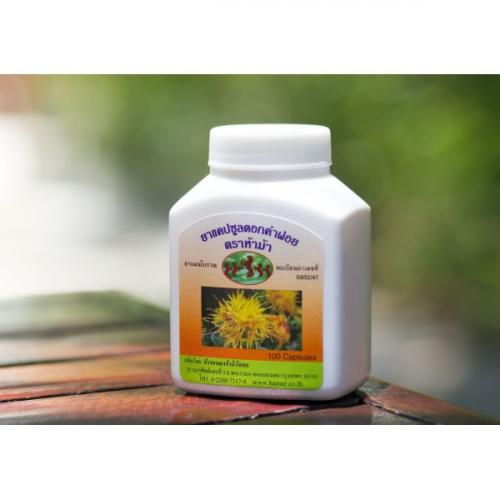

The beneficial properties of safflower
Get ready to check out this impressive list.
- Relieves tension in the nervous system, used in the treatment of insomnia.
- Pain reliever.
- It has a mild laxative effect.
- It is used as a diuretic.
- It has a choleretic effect.
- Lowers blood pressure.
- Effective in cardiovascular diseases.
- It is able to lower total cholesterol levels and increase the proportion of high-density lipoproteins, which in translation from medical to human means good cholesterol.
- Cleans the walls of blood vessels from settled cholesterol plaques.
- It is used to prevent osteoporosis.
- Normalizes the menstrual cycle and reduces soreness during menstruation.
- In the treatment of diabetes, it is used to maintain blood sugar levels.
- Natural antioxidant.
- Able to bind and remove toxins from the body. Gives a good result for the fight against poisoning.
- Antineoplastic agent.Cleansing the body of harmful substances reduces the risk of cell proliferation.
- Anti-inflammatory action. Accelerates the healing of purulent wounds and ulcers.
- During colds, it is used as an immunomodulator.
- Accelerates metabolic processes, which earned its rightful place in the first-aid kits of weight-watching and losing weight people.
Biochemical composition of wild saffron
An impressive range of applications is due to the biochemical composition.
Contains:
- A whole complex of vitamins - A, D, B12, B6 and C.
- Minerals - sodium, potassium, calcium, iron, magnesium.
- Source of glycosides.
- Safflower oil contains oleic and linoleic acids. The latter, by the way, is not produced in the human body, but is indispensable for normal functioning at the cellular level and maintaining the elasticity of blood vessels.
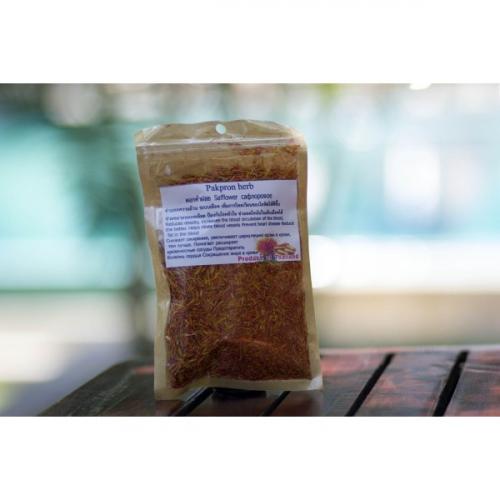

Contraindications
Like many medicinal herbs, safflower has a list of them.
- Pregnancy. Safflower can cause smooth muscle contractions, which can lead to premature birth.
- Pathological uterine bleeding.
- Poorly combined with drugs, in particular, should not be used in conjunction with anticoagulants.
- Individual intolerance. Where without her!
- Problems with the gastrointestinal tract.
The list is small, but you shouldn't ignore it.
The external similarity of safflower flower petals with the famous and expensive saffron - the king of Indian spices - really takes place, which is often used by unscrupulous producers. It is not worth getting angry at such would-be manufactures, because negatively charged rays of karmic retribution are sent to them automatically. If you wish, it is possible to distinguish one from the other, and even more so this moment does not detract from the merits of the main character of today's review.
Everyone froze in anticipation of links from the site. Here they are, keep them.
- Capsules, 100 pcs - 275 rubles
- Safflower tea, 40 g - 165 rubles
Wishing you slimness, even blood pressure and a healthy heart, yours sincerely, Thai herb room researcher, Marta.
Sergey Koshkodan: Safflower is a culture of stable profit
Agricultural business is like a game of anticipation, where the conditions are set by the weather. This is a factor that cannot be changed, as well as one hundred percent predictable. Therefore, each action has to be calculated taking into account all kinds of changes. Over the years, however, each farmer has found his or her own way to resist this limiting force, and diversification is one of them.
Head of the farm "Koshkodan S.I." In the Zhangeldinsky district of the Kostanay region, Sergey Ivanovich Koshkodan considers it necessary in arid steppe conditions to have at least a minimum set of crops that are able to react the least to unpredictable weather conditions of the growing season. And he chose safflower for himself one of these cultures. For eight years of using it in crop rotation, the manager was convinced that he made the right choice.
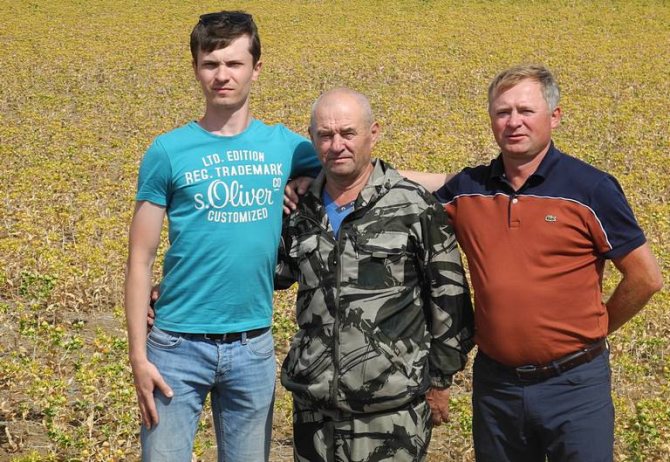

Three generations of the Koshkodan family
Diversification as a development path
— Sergey Ivanovich, what is the word “diversification” about for you personally? Is it a constant journey of trial and error, or is it more about the end result?
- Diversification for me is, first of all, a path of development, since we know how to grow wheat, but today, in order to be successful, this is no longer enough, and it is necessary to master other crops.
- So, in each region, these cultures are likely to be different. In the context of your farm, what kind of crops is strategically meaningful to cultivate, in your opinion?
- In addition to wheat, I grow safflower, I also try to introduce chickpeas into the structure of arable land, using a crop rotation in production. The alternation in it is as follows: wheat-wheat-safflower-safflower or wheat-chickpea-wheat-safflower-safflower. Today safflower occupies about 30-35% in the structure of the sown areas of the farm, another 2% is chickpea, and the rest is wheat.
- That is, safflower and chickpeas are able to "hedge" the farmer in unfavorable weather years?
- Safflower in dry years shows itself better than other crops in terms of yield. Under similar conditions, chickpeas yield yields at the level of wheat, but the selling price of chickpeas is higher than that of wheat by 30-40%, as well as safflower.
Risk is a noble cause
— How did your acquaintance with safflower begin?
- I have been growing safflower since 2012, it was a severely arid year, and then, according to the still unworked technology, it showed a yield of 5 c / ha, while wheat in a neighboring field gave 2 c / ha, and this difference interested me.
It all started with the search for new alternative, drought-resistant crops suitable for cultivation in our natural and climatic zone. At one of the seminars at the Kostanai Agricultural Research Institute in Zarechny, I met the agronomist Nikolai Petrovich Popov, who gave a lecture on safflower based on his own practical experience in its cultivation. I, as they say, "absorbed" all this, and, having bought seeds from their farm, sowed 200 hectares of safflower of the "Akmai" variety. He independently began to work out the technology, experiment with the seeding rate and sowing time, the structure in the crop rotation, and later acquired various varieties. In fact, I am still in constant search of new varieties and new knowledge, purposefully attending many seminars, conferences and exhibitions on agriculture.
- Was it difficult to organize the sale of the products obtained and where do you sell your oilseeds today?
- The first safflower sold hard, because I did not know the buyers, did not know the quality requirements. I just posted information wherever I could - on the Internet, in the newspaper, on the stock exchange. The first buyer was from Turkey. The next year, many already knew about my safflower. Now I'm not looking for buyers, they come by themselves. The main requirement is high quality safflower. Currently, I sell oilseeds to China, as they give the best price there.
Stable in yield, expensive in price
- How constant is the price of safflower compared to the price of wheat?
- Prices for safflower are definitely more stable than prices for wheat. Moreover, in the fall, the price for it is minimal and increases until June. So, if in the fall in 2020 I was offered to sell safflower at a price of 70,000 tenge per ton, then in May of this year - already for 120,000 tenge. I usually sell safflower in March, when the price is already at its peak.
- How have the safflower areas in your farm changed over the years?
- As I said, I started in 2012 with 200 hectares, and the next year I have already sown 1600 hectares. Of course, this was facilitated by subsidies per hectare. However, there were years when I reduced the area under crops, as I was faced with diseases on safflower. In 2020, we sowed 2,530 hectares with this crop.
- How does the yield of safflower vary from year to year?
- For 8 years, the yield of safflower varied from 5 to 14 c / ha. The lowest rate was observed in the first year of cultivation - 5 c / ha. The average yield for the previous 7 years was about 7-8 c / ha. 2020 was a year rich in precipitation, then the yield of safflower was in the range of 12-14 kg / ha. By the way, this was the year when I first sowed it earlier than usual. So, if before that I sowed safflower on May 10-15, then in 2020 I started sowing much earlier - on May 5-7, and in general, such a good result was obtained.
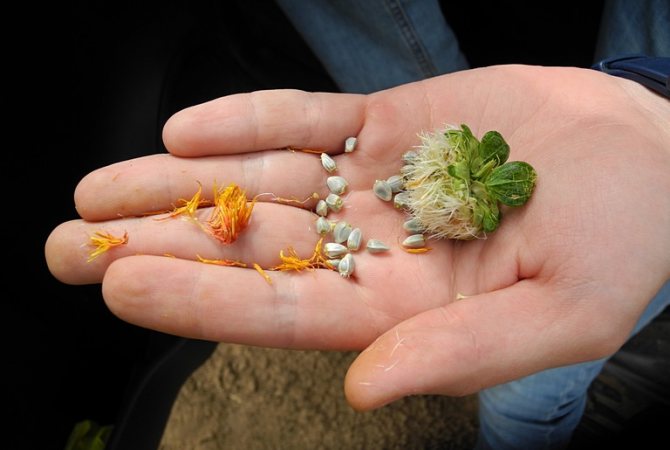

For varieties - to other lands
- How do you assess safflower in a crop rotation - which predecessor is good for it and what is it like as a predecessor?
- I place safflower in the crop rotation according to its predecessor wheat, but it happened that I sowed in different ways, including safflower according to safflower. There were fields where safflower was cultivated continuously for 5 years in the same field, but in the end I encountered diseases on safflower. Now I have made the best decision for myself: two years in a row it can be sown in the same field. So I went on a crop rotation: wheat-wheat, safflower-safflower. Now I am studying chickpeas in practical application, I am also trying to introduce it into crop rotation. I have been working with him for the second year now.
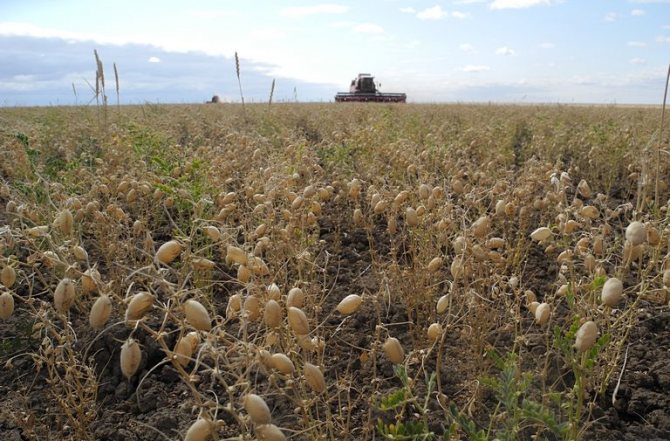

It must be said that on safflower sown on wheat, of course, it is necessary to work with an anti-cereal preparation one hundred percent, otherwise you will not get a high-quality crop without the addition of wheat.
The very same wheat in the field after safflower also grows well without reducing the yield, although not increasing.
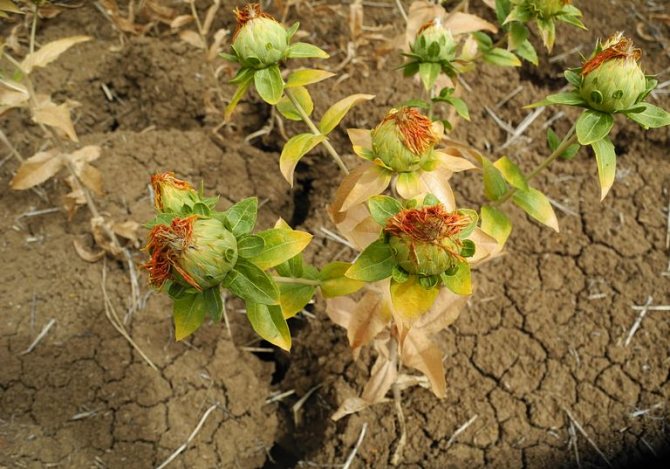

- What variety do you use and why? Is there any choice in this regard?
- I started with the "Akmai" variety of the Krasnovodopatskaya experimental station, the city of Shymkent. I sowed it for several years, while simultaneously trying to look for other varieties, I went to the Aktobe experimental station, where I acquired the Akhram variety, the elite. I must say that "Ahram" has a slightly longer growing season, 10-15 days.
Two years ago in Russia in Saratov I bought the Ershovsky-4 variety, the elite, it is distinguished by its whiteness, and this indicator is valued in safflower. Now "Ershovsky-4" is our first reproduction, it is a really beautiful variety in terms of whiteness, it gives excellent seeds.
Recently there was a seminar on safflower, where there was a representative from the Krasnovodopatskaya experimental station, in the process of communication I became interested in their other new varieties, which I now want to purchase for myself, including the Nurlan variety.
In our region, no one is engaged in the selection of safflower, we have to look in other regions of the country and abroad.
Early sowing culture
- How do you sow safflower - soil preparation, seeding rates, row spacing, timing?
- For sowing safflower we use seeders "Omichka" SKP-2,1, using sowing on stubble. Seeding rate from 22 kg to 30 kg / ha. The row spacing is the same as that of wheat - 23 cm. Timing: the sooner the better, I was convinced of this. Usually, around May 5, we start sowing safflower. I want to try even earlier - from the first days of May, or even at the end of April, but everything depends, of course, on the conditions of spring.
- How susceptible to weeds is safflower, how sensitive to weeds and how do you solve the problem with weeds in its crops?
- On safflower with weeds, we fight with anti-grass herbicides, the treatment with which we carry out until the branching phase with a rate of 0.8 -1.2 l / ha, depending on the stage of volunteer development. We must process safflower for wheat 100% in this way, and if we sow safflower for safflower, then we save and no longer process it, since the field is usually clean and there is no fall on it.
We use herbicides "Miura", as well as "Lemur" of Hungarian production.
Against dicotyledonous weeds, we work on the predecessor, since there are no preparations for them on the safflower, which means that the safflower field should be initially clean of dicotyledonous weeds.
- Do you have problems with diseases and pests?
- The first years of cultivation of pests on safflower were not, as well as diseases. But in the fourth or fifth year, he encountered root rot, which affected up to 30% of the plants. As a control method, before sowing, they began to treat the seeds with a seed dressing in combination with an insecticide, as well as to work during the growing season, adding an insecticide to tank mixtures during treatment against cereal weeds. So we got rid of this problem.
It's not scary to be late
- What are the problems with safflower during the harvesting process?
- We harvest safflower using the same combines as wheat. However, there was a problem with the reapers: part of the safflower was threshed in the reaper. As a solution, last year we purchased two belt headers, and we think that this will solve the problem.
Previously, we also encountered crushing, however, adjustments of the combine allow us to fix all this.
- Does safflower allow for delays in harvesting dates?
- Allows. Safflower does not crumble, does not fall, and this is also one of the significant advantages of this culture. That is, we sow it before wheat, and harvest it after wheat. If it rains during harvesting, safflower does not get wet as quickly as wheat, due to the fact that its achene is firmly closed. We harvest it at a moisture content of about 10%, which allows us to perfectly store oilseeds during the winter, waiting for high prices.
- How do you earn extra seeds after harvesting? Where do you store it? Are there any problems during storage?
- We do the initial part-time work by air on an UZM machine, after which we put it to storage in hangars. The purer the safflower, the longer and better stored. Of course, self-warming is characteristic of oilseeds. In the event that safflower lies motionless in warehouses for a long time, it begins to warm up. It is advisable to stir it up, for about a month or two it lies, then we move it, and then there are no problems.
2019: precipitation fell on time
- How would you characterize the conditions of this particular year in your region, how was the sowing process and how would you rate the growing season?
- In the spring, before sowing, the moisture in the meter layer of soil was up to a depth of 50-70 cm. Proceeding from the fact that such reserves are not enough, we decided to sow more safflower. Sowed safely, the rains did not interfere with the sowing. In general, the sowing campaign went smoothly, well and on time. We even finished our sowing a little earlier than usual.
At the beginning of summer, there was good rainfall, which fell just in the safflower steming phase, due to which the plants developed well. During the flowering period, there was practically no rain, which is also good, since heavy rainfall negatively affects pollination and subsequently many empty seeds are formed, which, of course, affects the yield. Safflower blooms for almost a month. Now the safflower is at the stage of maturation, it is still green, just pouring in, it is raining, which is also good.
- Is it possible to say already today what preliminary yield of safflower is expected by the time of harvesting? Can you compare it with wheat?
- The specific yield of safflower today is 7-8 c / ha. Wheat, which we began to harvest on August 18 - 4 c / ha. So it turns out that in such a dry year, the yield of safflower is almost 2 times higher than that of wheat. In addition, the price for it, as a rule, is 30-40% higher. But profitability is made up of these indicators.
The guarantor of the well-being of the economy
- State support for diversification - how is it manifested if we are talking about safflower?
- At first, the state support was in the form of a little more than three thousand tenge per hectare of safflower sowing, then the numbers gradually increased to 11,000 tenge / ha. At that time, I sowed about 1000 hectares, and this was a significant help, which made it possible to recoup almost all the costs of safflower. Then these times ended, but then I already learned how to cultivate it and continue to deal with it to this day, as I see the effect - safflower acts as a guarantor of a healthy financial state of the economy.
- What are your future plans for working with this culture?
- Plans - to sow safflower. As for the area, we would like to increase them, but the fact is that in the area we are limited by crop rotation, since safflower must be moved through the fields every two years. With the aim of expanding, I recently took land. I think over time we will even increase the area under safflower up to 5,000 hectares. At the same time, I will introduce new varieties.
In my region, I promote the cultivation of safflower. Of course, in the first years, when subsidies were paid, many in the district got involved in this business, took seeds from me, but many did this exclusively because of subsidies. As soon as the subsidies ended, a significant part of the farmers stopped doing it. But there are persistent guys who are still growing safflower. I am absolutely sure that safflower is a promising culture. For eight years of cultivation, I have mastered its technology, but I will still improve.
***
SAFFLOR VARIETIES. DESCRIPTION
AKMAY
Originator: LLP "Krasnovodopadskaya Breeding Experimental Station"
Origin: Created by individual selection from the local population of the South Kazakhstan region.
General characteristics: The variety is mid-season. Plant height 80-90 cm. The variety has high productivity.
Approbation signs: Characteristics of the bush during flowering, corymbose-branching. The stem is rounded. Branching 8-18 pcs., Spreading. Leaf shape is elliptical, sessile, whole-cut, without pubescence. The leafiness is medium, without thorns. The characteristic of the baskets is convex, the average number of baskets per 1 plant is 8-18 pcs., Does not tilt. The diameter of the basket is 2-3 cm. The color of the flowers is burgundy, without thorns. The leaflets are thyroid. The mass of seeds in 1 basket is 1.4-1.9 gr.
Productivity: The average yield for 3 years of competitive variety testing was 11.6 c / ha.
Qualitative indicators: The mass of 1000 seeds is 39-41 g, the fat content in absolutely dry seeds is 36-37%, in the kernel 55-55.7%.
Disease and climatic resistance: Drought tolerant variety.
Recommendations: For cultivation in Aktobe, Almaty, Zhambyl, Kyzylorda, South Kazakhstan regions.
AHRAM
Originator: LLP "Aktobe Agricultural Chemical Plant"
Bred by the method of individual selection from the RS-223 variety of the collection of the international center CIMMYT (Mexico).
Under the conditions of the Aktobe region, the length of the growing season of the variety is 97-120 days, it belongs to the late-ripening group with an extended period from flowering to ripening.
Plants have a compact form, the number of branches of the first order is 6-8, the number of baskets per plant is 10-16 pcs., The height of plants is 45-65 cm.The weight of 1000 seeds is 44.0-45.2 g. Oil content of seeds is 33 -35%. Productivity 9.0-15.5 c / ha.
Technical and economic parameters: the production and cultivation of new varieties of safflower adapted to arid conditions for oilseeds is very profitable. The costs incurred provide a low cost of safflower oilseeds in the range of 8.1-11.3 tenge / kg. The yield of oil per hectare for the Akhram variety was 286 kg, which is 90 kg higher than that of the Akmai variety.
NURLAN
Originator: LLP "Krasnovodopadskaya Breeding Experimental Station"
Origin: Created by the method of multiple individual selection from the local population of the South Kazakhstan region.
General characteristics: The variety is mid-season. Plant height 70-80 cm.
Approbation characteristics: Stem round, glabrous. The shape of the bush is pressed. Branches 6-18 pcs. The leaf is ellipsoidal, sessile, dark green, without pubescence, without thorns. The basket is concave, 2.5 cm in diameter, the amount is 8-24. The flowers are claret red. The seeds are white, with tough gray husks.
Productivity: The average yield for 3 years of competitive variety testing was 11.1 c / ha.
Qualitative indicators: The mass of 1000 seeds is 39-41 g, the fat content in absolutely dry seeds is 36-37%, in the kernel 55-55.7%.
Disease and climatic resistance: The variety is drought-resistant and heat-resistant.
Recommendations: For cultivation in Aktobe, Karaganda, Kyzylorda, South Kazakhstan regions
ERSHOVSKY 4
Seed yield: 14-17 c / ha.
Weight of 1000 seeds: 48-55 gr.
Hull content: 42-47%.
Duration of the period from sowing to full germination: 8-12 days, from germination to the beginning of branching 21-28 days, from branching to flowering 32-40 days, from flowering to ripening 38-55 days, from germination to ripening 95-115 days.
Resistance to soil and air drought - 5 points.
The seeds contain 28-34% oil.
Over the years of research, no signs of disease have been found.
Seed growing zones: Saratov, Orenburg, Volgograd and Astrakhan regions, Lower Volga, Ural and Middle Volga regions.
Differs in high whiteness. It is in high demand among consumers. In demand for export sales.
Irina Gavrilenko
Published in the magazine "Agrobusiness.Kazakhstan", August 2019
Previous post
The soil under the pastures suffers in the WKO. Sorghum, alfalfa and millet brine the soils in the south. Nut business in Kazakhstan: realities and prospects
Next post
Senator proposes to conduct a complete inventory of the state grain reserve
Tea - who is useful and how to prepare
It is a very common practice to make tea from safflower.The drink has been popular for centuries. Its main property is a tangible diuretic effect. Since ancient times, it has been used to treat and cleanse the kidneys.
Tea is also believed to be beneficial for those suffering from heart failure or anemia. To obtain the result, you must consume the drink for 1-1.5 months. Tea is prepared from flower petals as follows.
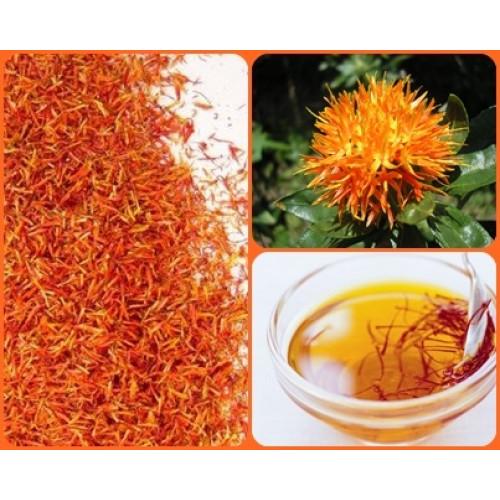

Method 1
To prepare a drink 0.5 tsp. raw materials are poured with a cup of boiling water, and insisted for half an hour. The product cleanses and restores the intestinal walls, has an anti-inflammatory effect and improves the condition of the skin. Tea soothes and relieves stress after a hard day. Therefore, it is recommended to drink at night. Several cups per day are allowed.
Method 2
Pour 1 tsp. raw materials with 1 liter of hot water and boil for several minutes. You need to drink 4 glasses a day. This recipe is recommended for people with significant skin diseases (for example, psoriasis). The finished product should be stored in the refrigerator.
Please note that this drink should not be combined with other medicinal infusions and teas. And you need to store in a cool, dark place.


